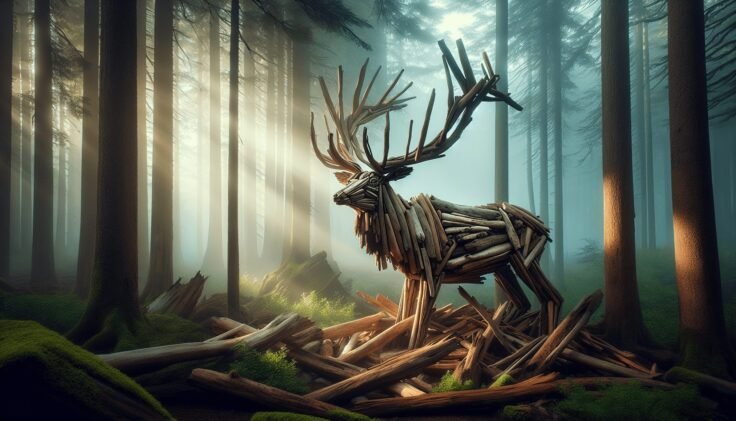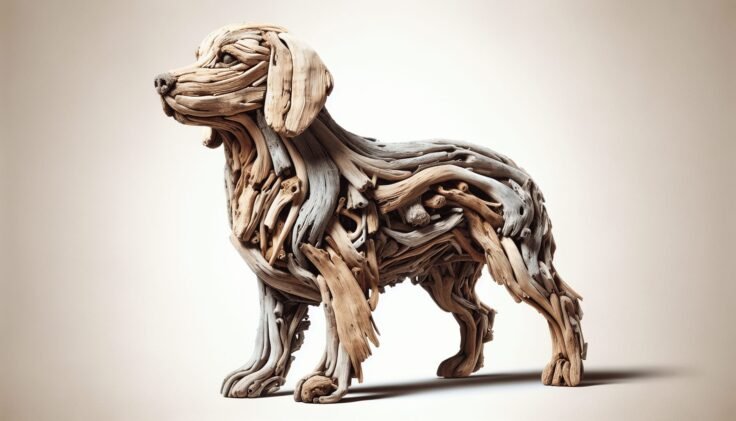Have you ever wandered along a scenic beach and found yourself mesmerized by beautifully sculpted pieces of driftwood? These remarkable natural sculptures can spark the imagination, turning humble pieces of wood into fascinating works of art. Among the many natural creations found on coastlines, one of the most intriguing is known as the “Driftwood Elk.” Let’s explore this unique phenomenon, examining its origins, creation, and the art forms it inspires.

What is Driftwood?
Before diving into the specifics of driftwood elk, it’s important to understand what driftwood is. Driftwood is wood that has been washed onto a shore or beach by the action of winds, tides, or waves. Beyond its visually striking appearance, driftwood plays a vital role in coastal ecosystems, providing habitat and food for a range of species.
Formation and Journey
Driftwood begins its journey when trees fall and land in rivers, lakes, or the ocean. The wood then travels with the flowing water, undergoing a transformation process. The constant abrasion of sand and water polishes the wood, smoothing out any sharp edges. Over time, the once green and vibrant wood is bleached and shaped by natural forces into elegant and abstract forms, making each piece truly unique.
Ecological Importance
Beyond its aesthetic appeal, driftwood has several ecological functions. It provides critical nesting and living spaces for numerous wildlife species. Birds, insects, and marine organisms often rely on the nooks and crannies of driftwood for shelter. Moreover, as driftwood breaks down, it contributes organic material and nutrients to coastal ecosystems, supporting plant and animal life.
Driftwood Elk: Nature’s Artwork
The concept of driftwood elk emerges from the combination of nature’s forces and human creativity. The term refers to sculptures crafted from driftwood, designed to resemble elk. While the wood’s natural shapes provide the foundation, it’s the artist’s skill that brings these majestic animals to life.
Inspiration Behind Driftwood Elk
Elk are among the most magnificent creatures in the animal kingdom, known for their grace and strength. The driftwood elk captures these attributes, transforming fallen and forgotten pieces of wood into symbolic representations of wildlife. These sculptures not only celebrate the natural world’s beauty but also highlight our connection to it.
The Artistic Process
Creating a driftwood elk involves several steps. Artists begin by selecting pieces of driftwood that suggest the contours and features of an elk. Each piece is carefully chosen to fit a specific part of the elk’s anatomy, from antlers to the elegant curve of a neck. The assembly requires a keen eye for detail and an understanding of both the animal’s form and the qualities of the driftwood. Some artists may use minimal other materials, letting the power and grain of the wood speak for itself, while others might incorporate metal or glass to enhance the sculpture’s visual impact.
Challenges and Techniques
Working with driftwood poses unique challenges due to its irregular shapes and varied sizes. Artists need to adapt their methods to each piece of wood. Techniques such as sanding, carving, and joining are essential to shape the wood and maintain the natural characteristics that make each sculpture one-of-a-kind. Many artists also use innovative techniques to ensure the stability and durability of their creations.
The Symbolism of Elk in Art
Elk have long held significant cultural and spiritual symbolism across various societies. Understanding this symbolism adds depth to the appreciation of driftwood elk sculptures.
Elk in Native American Culture
In Native American cultures, elk are revered for their strength, agility, and endurance. They symbolize stamina and perseverance. Some tribes associate elk with love and passion due to the animals’ powerful mating calls and courtship behaviors. The presence of elk in Native American art frequently represents these qualities, embodying a connection with nature and the spirit world.
Elk in Modern Symbolism
In contemporary times, elk are often seen as symbols of wild and untamed beauty. Representing the grandeur of nature, they are associated with freedom and the wilderness. Driftwood elk art captures this essence, reminding us of the majesty and mystery of wildlife.
Driftwood Art Beyond Elk
While driftwood elk may capture the imagination, the art form extends far beyond these sculptures. Driftwood provides the basis for a wide range of artistic expressions, from abstract installations to functional furniture.
Driftwood Sculptures
Apart from elk, artists create a variety of animal figures, such as horses, birds, and marine creatures. Each sculpture reflects the individual characteristics of the wood and the artist’s interpretation, resulting in unique and evocative pieces.
Functional Art and Furniture
Some artisans use driftwood to craft functional items like tables, chairs, and lamps. These pieces blend practicality with the natural beauty of the wood, offering unique home decor options. The texture and form of driftwood can add an organic element to any space, bringing a sense of the outdoors inside.
Driftwood and Environmental Art
Driftwood has also found its place in environmental art, where artists use natural materials to create installations that highlight the relationship between humans and the environment. These works often address themes of conservation and sustainability, encouraging viewers to reflect on their connection to nature.

Finding Your Own Driftwood
If you’re inspired to create your own driftwood art or simply want to collect unique pieces, knowing where and how to find driftwood is key.
Best Locations for Driftwood
Driftwood can be found along the shorelines of oceans, seas, lakes, and rivers. Beaches that experience strong tides and currents are often rich in driftwood due to the forces that bring wood from the water onto land. Some of the most famous driftwood beaches can be found along the Pacific Coast of North America due to its extensive coastline and active weather patterns.
Tips for Collecting
When collecting driftwood, it’s important to consider the sustainability and legality of your actions. Ensure that collecting is permitted in the area—some regions may have restrictions to protect delicate ecosystems. Leave behind any pieces that seem to be integral to the local wildlife habitat. Always be mindful of the environment, taking only what you need, and respecting the natural setting.
Cleaning and Preparing Driftwood
Once you’ve collected your driftwood, preparing it for artistic use is essential. Though the weathered appearance of driftwood is often desirable, cleaning helps remove any debris, insects, or salt deposits. A simple method is to soak the driftwood in fresh water for a few days, changing the water regularly. After soaking, allow the wood to dry thoroughly, completing the preparation process.
Get Started with Driftwood Elk Creation
Ready to try your hand at creating a driftwood elk or another sculpture? While each project is unique, some basic steps can guide you in getting started with driftwood art.
Gather Your Materials
In addition to driftwood, gather tools and materials that you’ll need for assembly, such as wire, nails, or adhesives. Consider whether you want to incorporate additional materials like feathers, stones, or metal to accent your sculpture. Choose tools that will allow you to cut, shape, and join the driftwood as needed.
Plan and Design
Sketch an outline or detailed plan of your desired sculpture. Consider not just the physical form but also the emotional impact and symbolism of your piece. This planning stage helps identify which pieces of driftwood will work best and how they will fit together.
Assemble Your Sculpture
Start building your sculpture with the main structural pieces, such as the body and legs of your elk. Gradually add more detailed elements like antlers and facial features. Use your tools to cut and shape the wood, ensuring stability and cohesiveness in the overall structure. Allow your creativity to guide you, and don’t hesitate to make adjustments as you go.
Finish and Preserve
Once your sculpture is complete, you can choose to preserve the wood’s appearance and durability. Apply a clear wood sealant or finish to protect against moisture and wear. This step is particularly important if your sculpture will be displayed outdoors.
The Driftwood Elk Community
Creating driftwood art, including driftwood elk, can connect you with a vibrant community of artists and enthusiasts who share your passion for this unique form.
Workshops and Classes
Many areas offer workshops and classes on driftwood art, where you can learn techniques and get hands-on experience. These sessions are excellent for beginners looking to gain practical skills and interact with experienced artists.
Online Communities and Resources
Join online forums, social media groups, and websites dedicated to driftwood art. These platforms are great for sharing your work, getting feedback, and finding inspiration. You might discover new artists, tips, and projects that spark your creativity.
Exhibitions and Galleries
Explore galleries and exhibitions that feature driftwood sculptures. Here, you can see a variety of styles and forms, engaging with the work of established artists. Exhibitions also provide an opportunity to display your creations to a broader audience.
Conclusion
Driftwood elk combine the raw beauty of nature with the skill and imagination of human artistry. These sculptures are more than artistic endeavors—they are testament to the delicate balance between natural forces and creative expression. Whether you become a collector or an artist yourself, driftwood elk offer a distinctive way to connect with the natural world. Embrace the challenge and joy of transforming simple pieces of driftwood into meaningful works of art that capture the majestic spirit of the elk.

















